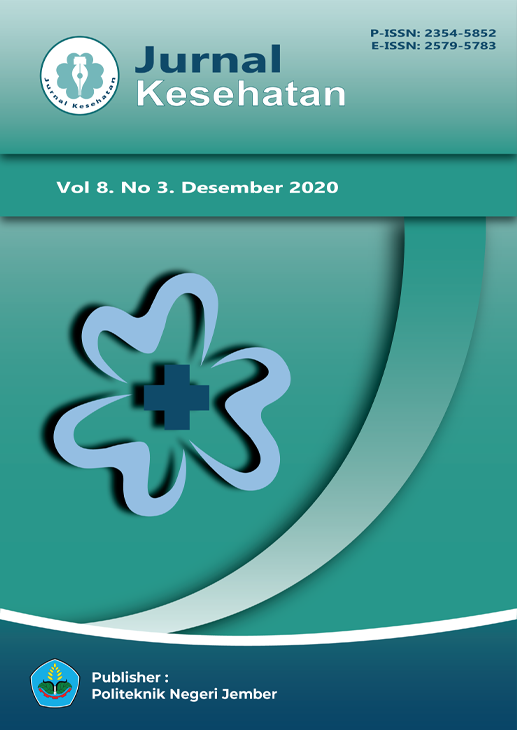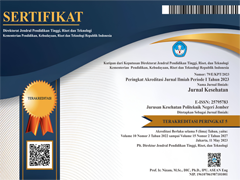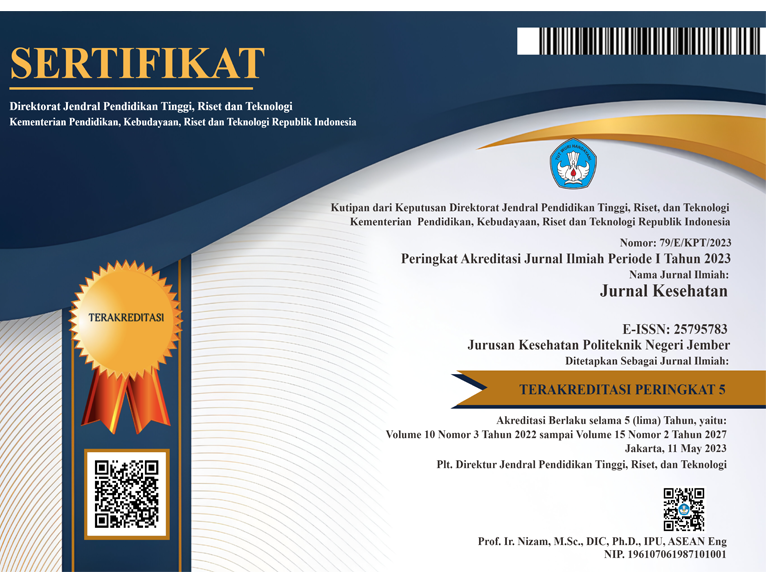Analisis Kluster Kejadian Stunting pada Balita di Provinsi Kalimantan Timur
DOI:
10.25047/j-kes.v8i3.183Downloads
Abstract
Malnutrition is still a major problem in Indonesia. Stunting (short stature) is a form of malnutrition in which a very short and short stature exceeds a 2 SD deficit below the median length or height of the population. The prevalence of short and very short toddlers nationally according to Riskesdas 2018 reaches 30.8%. The incidence of stunting in East Kalimantan Province in 2017 reached 30.86%, but there is no area categorization based on the prevalence of stunting in each Public Health Service (PHS). It is need to conduct the reseacrh to cluster the incidence of stunting based on other health parameters. The unit analysis of this study was 187 PHS in East Kalimantan Province, the data source was obtained from the Health Profile of the East Kalimantan Province, the data analysis used K-mean cluster with alpha 5%. The determination of the cluster is based on the incidence of stunting, LBW, Exclusive Breastfeeding and Complete Basic Immunization (CBI) in East Kalimantan Province. The results showed that there were 3 PHS clusters in East Kalimantan Province. Cluster 1 consists of 77 PHS with low incidence rates of stunting and LBW of 18.1% and 7.13%, cluster 2 consists of 109 PHS with low rates of stunting and LBW namely 8.04% and 2.7%, while cluster 3 consisted of 1 PHS with incidence of stunting, LBW and CBI above the total average, namely 15.2%, 12.5% and 323.8%. The highest incidence of stunting is at PHS Cluster 1 wich having a low coverage of Exclusive breasfeeding and CBI. It is more influenced by the topography of the Kutai Kartanegara area, where several areas are located on the coast and inland so the health workers get difficulties in accessing the community because they have to be reached by sea, river and lake.Keywords:
Exclusive breastfeeding, toddlers, LBW, complete basic immunization, stunting.References
Amsalu, S. 2008. Risk Factors For Severe Acute Malnutrition In Children Under The Age Of Five, Ethiopian Journal of Health Sciences Dev., 22 (1): 21-25
Bappenas. (2011). Rencana Aksi Nasional Pangan dan Gizi 2011 2015.http://www.4shared.com/get/
I45gBOZ/Rencana_Aksi_Nasional_Pangan .Diakses 10 November 2018
Dandara swathma, Hariati lestari, Ririn Teguh Ardiansyah (2016) Analisis Faktor Risiko BBLR, Panjang badan bayi saat lahir Dan Riwayat Imunisasi dasar terhadap kejadian Stunting pada Balita usia 12-36 Bulan DIi Wilayah Kerja Puskemas Kandai Kota Kendari Jurnal Indonesia Fakultas Kesehatan Masyarakat Universitas Halu Oleo : Page 1 -10
Dinas Kesehatan Provinsi Kalimantan Timur, Profil Kesehatan Propinsi Kalimantan Timur , Tahun 2018
Dinas Kesehatan Provinsi Kalimantan Timur, Profil Kesehatan Propinsi Kalimantan Timur , Tahun 2018
Fikadu, T., Assegid, S. & Dube, L. (2014). Factor associated with stunting among children age 24 to 59 months in Meskan District, Gurage Zone, South Ethiopia: A case-control study. BMC Public Health, 14(800).Tersedia :http://www.biomedcentral.com/1471-2458/14/800
Kania, D.(2015). Indonesia Peringkat Lima Besar Anak Penderita Stunting. https://lifestyle.okezone.com/
read/2015/01/23/481/1096366/indonesia-peringkatlima- besar-anak-penderita-stunting. diakses pada tanggal 6 Oktober 2016
Lestari, Margawati & Rahfiludin. (2014). Faktor Risiko Stunting Pada Anak Umur 6-24 bulan di kecamatan Penanggalan kota Subulussalam provinsi Aceh. Jurnal Gizi Indonesia (ISSN : 1858- 4942).
Neldawati.(2006). Hubungan Pola Pemberian Makanan pada Anak dan Karakteristik Lain dengan Status Gizi di Laboratorium Gizi Masyarakat. Puslitbang Gizi dan Makanan (P3GM) (Analisis Data Sekunder Data Balita Gizi Buruk Tahun 2005). Depok: FKM UI
Paudel, R., Pradhan, B., Wagle, R. R., Pahari, D.P., & Onta S. R. (2012). Risk factors for stunting among children: A community based case control study in Nepal. athmandu University Medical Journal, 10(3), 18-24
Proverawati, A & Ismawati, C. (2010). Berat badan lahir rendah . Yogyakarta: Muha medik
Riskesdas.(2018). Riset Kesehatan Dasar 2018.Badan Penelitian dan Pengembangan Kesehatan Kementerian Kesehatan RI
WHO, 2011. World Health Statistics. Geneva
WHO, 2015 Commission on Ending Childhood besity.Geneva,World Health Organization, Departement of Noncommunicable disease surveillance
License
Authors who publish in this journal agree to the following terms:
1. Copyright belongs to the medical journal as a publication
2. The author retains copyright and grants the journal rights to the first publication carried out simultaneously under a Creative Commons Attribution License which allows others to share the work with an acknowledgment of the author's work and initial publication in this journal.
3. Authors may enter into separate additional contractual arrangements for the non-exclusive distribution of the work (eg sending it to an institutional repository or publishing it in a book) with acknowledgment of initial publication in this journal.
4. Authors are permitted and encouraged to post work online (eg in institutional repositories or on their websites) before and during the submission process, as before and larger citations of published work (see Effects of Open Access).
Selengkapnya tentang teks sumber ini














